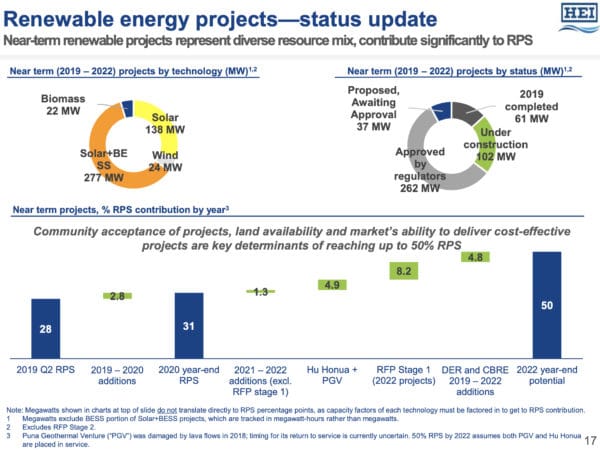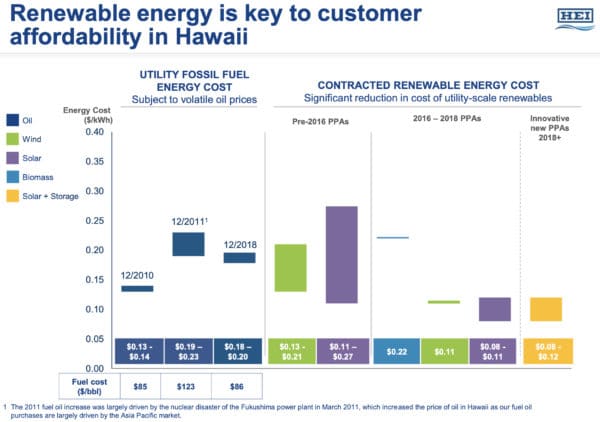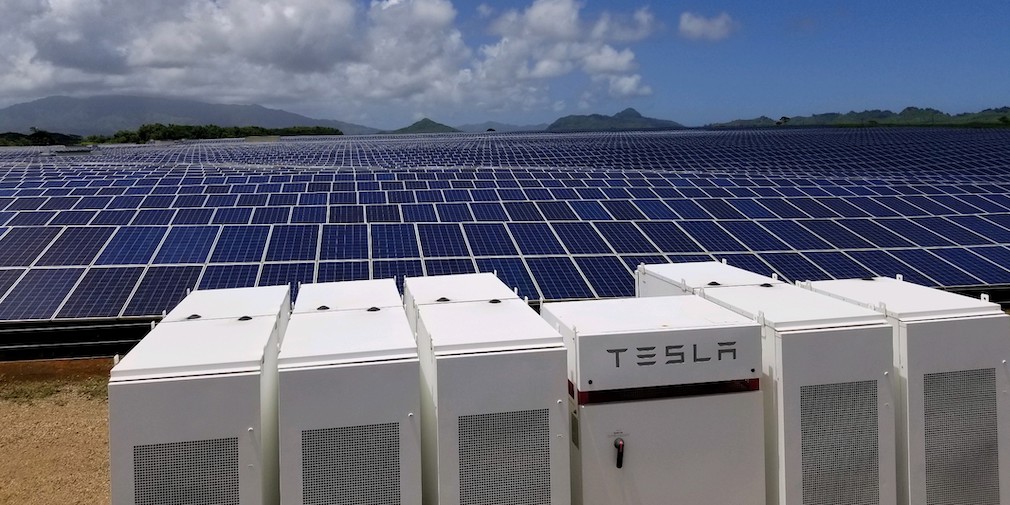Hawaiian Electric expects to reach 31% renewable generation by this December, and could reach 50% by year-end 2022. That will depend on community acceptance of projects, land availability, and cost-effective pricing, the utility said in an investor presentation.
The utility foresees reaching 70% renewables by the late 2020s, if the 75 bids it received last November for 900 MW of wind and solar power, plus storage and grid services, are found to be cost-effective.
These levels of renewables would exceed the interim targets of Hawaii’s renewable portfolio standard, which calls for 100% renewables by 2045. The utility’s path to 50% renewables is illustrated here, with the number “50” shown at the bottom right; “BESS” means battery storage:

Hawaiian Electric says that “renewable energy is key to customer affordability in Hawaii,” with affordable solar+storage shown in orange at the right of this chart:

Under its innovative solar+storage contracts, Hawaiian Electric matches all new solar capacity that it procures with an equal capacity of four-hour-duration storage.
The utility does not purchase the power produced by each solar+storage installation, but instead makes a fixed monthly payment to the plant owner; the utility controls the dispatch of the solar+storage plant.
This “renewable dispatchable generation” allows Hawaiian Electric to “integrate more renewable energy, and provides flexibility, while addressing some of the financing risks previously associated with curtailment,” says a report from the Electric Power Research Institute, written by Robin Bedilion. The solar+storage plants will “contribute to the islands’ operating reserves and power quality,” adds the report.
First Solar has advised utilities to follow this approach of purchasing solar capacity, rather than power, to permit flexible solar plant operations.
Hawaiian Electric counts nearly 77,000 residential PV systems in its service territory, and says that customer-sited distribution is “central” to its renewables strategy. That’s because meeting the 100% renewables standard “is not possible” solely with utility-scale projects, the utility says, due to limited land availability and competing priorities for land use, such as for agriculture and housing.
Hawaiian Electric’s path to reach 50% renewables by year-end 2022, and 70% renewables by the late 2020s, is in line with a consulting firm’s 2018 analysis showing that the state’s least-cost path would achieve 46% renewables by 2021, and 58% to 84% renewables by 2030. The activist hedge fund ValueAct, citing that study, began a dialog with utility management in late 2018 after reporting ownership of just over 1% of the shares of Hawaiian Electric Industries, the parent company of Hawaiian Electric.
Kauai Island Utility Cooperative, serving one of the smaller Hawaiian islands, has already achieved over 50% renewable generation.
This content is protected by copyright and may not be reused. If you want to cooperate with us and would like to reuse some of our content, please contact: editors@pv-magazine.com.








By submitting this form you agree to pv magazine using your data for the purposes of publishing your comment.
Your personal data will only be disclosed or otherwise transmitted to third parties for the purposes of spam filtering or if this is necessary for technical maintenance of the website. Any other transfer to third parties will not take place unless this is justified on the basis of applicable data protection regulations or if pv magazine is legally obliged to do so.
You may revoke this consent at any time with effect for the future, in which case your personal data will be deleted immediately. Otherwise, your data will be deleted if pv magazine has processed your request or the purpose of data storage is fulfilled.
Further information on data privacy can be found in our Data Protection Policy.